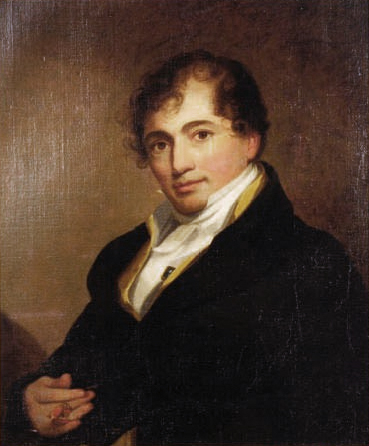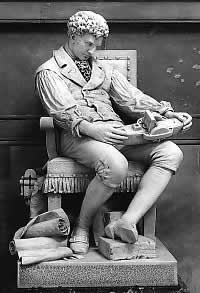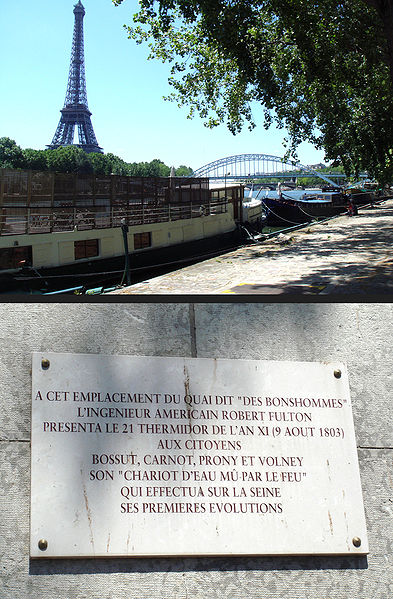<Back to Index>
- Engineer Robert Fulton, 1765
- Poet Leopold Staff, 1878
- General of the Philippine Revolutionary Army Gregorio del Pilar y Sempio, 1875
PAGE SPONSOR



Robert Fulton (November 14, 1765 – February 24, 1815) was an American engineer and inventor who is widely credited with developing the first commercially successful steamboat. In 1800 he was commissioned by Napoleon Bonaparte to design the Nautilus, which was the first practical submarine in history.
Fulton became interested in steamboats in 1777 when he visited William Henry of Lancaster, Pennsylvania, who had earlier learned about James Watt's steam engine on a visit to England. Robert Fulton died from exposure in 1815. Robert Fulton was born on a farm in Little Britain, Pennsylvania,
on November 14, 1765. His father, Robert Fulton, was born in Ireland
and emigrated to Philadelphia where he married Mary Smith. The father
moved the family to Lancaster, Pennsylvania, where the younger Fulton attended a Quaker elementary
school. Fulton showed an early interest in mechanical things. At the
early age of 13, he invented paddle wheels to go alongside his father's
fishing boat. He especially favored gunsmiths and even offered some
suggestions that were adopted by the workmen. As a boy he built rockets and experimented with mercury and bullets. His friends nicknamed him “Quicksilver Bob.” He
learned to sketch early on and by age 17 he decided to become an
artist. His father, who had died when Robert was three, had been a
close friend to the father of painter Ben West. Fulton later met West in England and they became friends. Fulton
stayed in Philadelphia for six years, where he painted portraits and
landscapes, drew houses and machinery, and was able to send money home
to help support his mother. In 1785 he bought a farm at Hopewell, Pennsylvania, for £80 Sterling and moved his mother and family onto it. While in Philadelphia, he met Benjamin Franklin and other prominent Revolutionary War figures. At age 23 he decided to visit Europe.
He
took several letters of introduction to Americans abroad from the
individuals he had met in Philadelphia. He had already corresponded
with Benjamin West, and West took Fulton into his home, where Fulton
lived for several years. West had become well known and introduced
Fulton to many others. Fulton gained many commissions painting
portraits and landscapes, which allowed him to support himself, but he
continually experimented with mechanical inventions. He
published a pamphlet about canals and patented a dredging machine and
several other inventions. In 1797 he went to Paris where his fame as an
inventor was well known. In Paris, Fulton studied French, German,
mathematics and chemistry. He began to design torpedoes and submarines.
In Paris Fulton met James Rumsey, who sat for a portrait in the studio of Benjamin West where Robert Fulton was an apprentice. Rumsey was an inventor from Virginia
who ran his own first steamboat in Shepherdstown (now in West Virginia)
in 1786. As early as 1793, Fulton proposed plans for steam powered
vessels to both the United States and British governments, and in
England he met the Duke of Bridgewater, whose canal was used for trials of a steam tug, and who later ordered steam tugs from William Symington.
Symington had successfully tried steamboats in 1788, and it seems
probable that Fulton was aware of these developments. The first
successful trial run of a steamboat had been made by inventor John Fitch on the Delaware River on August 22, 1787, in the presence of delegates from the Constitutional Convention. It was propelled by a bank of oars on either side of the boat. The
following year Fitch launched a 60 foot (18 m) boat powered by a
steam engine driving several stern mounted oars. These oars paddled in
a manner similar to the motion of a swimming duck's feet. With this
boat he carried up to thirty passengers on numerous round trip voyages
between Philadelphia and Burlington, New Jersey. Fitch was granted a patent on
August 26, 1791, after a battle with Rumsey, who had created a similar
invention. Unfortunately the newly created Patent Commission did not
award the broad monopoly patent that Fitch had asked for, but a patent
of the modern kind, for the new design of Fitch's steamboat. It also
awarded patents to Rumsey and John Stevens for
their steamboat designs, and the loss of a monopoly caused many of
Fitch's investors to leave his company. While his boats were
mechanically successful, Fitch failed to pay sufficient attention to
construction and operating costs and was unable to justify the economic
benefits of steam navigation. It was Fulton who would turn Fitch's idea
profitable decades later. In 1797, Fulton went to France, where Claude de Jouffroy had made a working paddle steamer in 1783, and commenced experimenting with submarine torpedoes and torpedo boats. Fulton is the inventor of the first panorama to be shown in Paris, which was complete by 1800 Vue de Paris depuis les Tuilerie painted by Pierre Prévost,
Jean Mouchet and Denis Fontaine. The street where his panorama was
shown is still called "'Rue des Panoramas'" (Panorama Street) today. Fulton designed the first working submarine, the Nautilus between
1793 and 1797, while living in France. He asked the government to
subsidize its construction but he was turned down twice. Eventually he
approached the Minister of Marine himself and in 1800 was granted
permission to build. In France Fulton also met Robert R. Livingston who was appointed U.S. Ambassador to France in 1801, and they decided to build a steamboat together and try running it on the Seine.
Fulton experimented with the water resistance of various hull shapes,
made drawings and models, and had a steamboat constructed. At the first
trial the boat ran perfectly, but the hull was later rebuilt and
strengthened, and on August 9, 1803, this boat steamed up the River
Seine, but sank. The boat was 66 feet (20.1 m) long, 8 feet
(2.4 m) beam, and made between 3 and 4 miles per hour (4.8 and 6.4
km/h) against the current. In 1806, Fulton married Harriet Livingston, the niece of Robert Livingston and daughter of Walter Livingston.
They had four children: Robert, Julia, Mary and Cornelia. In 1807,
Fulton and Livingston together built the first commercial steamboat, the North River Steamboat (later known as the Clermont), which carried passengers between New York City and Albany, New York. The Clermont was able to make the 300 mile trip in 32 hours. From 1811 until his death, Fulton was a member of the Erie Canal Commission. Fulton died in 1815. He is buried in the Trinity Church Cemetery in New York City, alongside other famous Americans such as Alexander Hamilton and Albert Gallatin. His descendants include former Major League Baseball pitcher Cory Lidle and Stacy Ogier Hancock.
In 1816, the Commonwealth of
Pennsylvania donated a marble statue of Fulton to the National Statuary Hall Collection in the US Capitol Building. Fulton was also honored for his development of steamship technology in New York City's Hudson - Fulton Celebration of 1909. A replica of his first steam powered steam vessel, the Clermont, was built for the occasion. Many places in the U.S. are named for Robert Fulton.